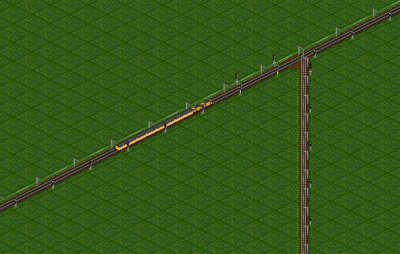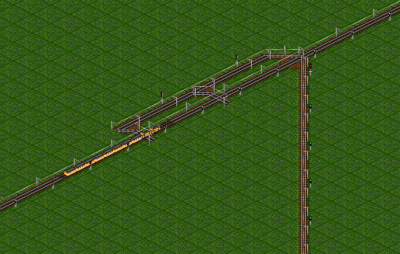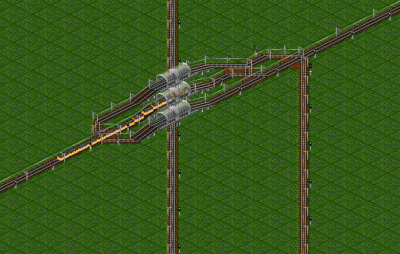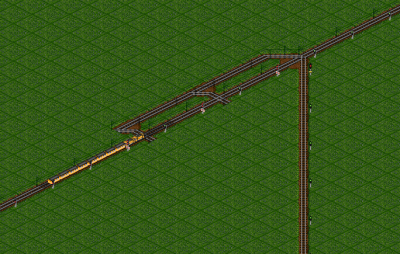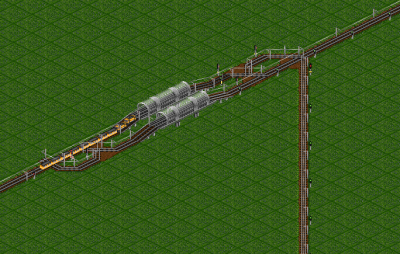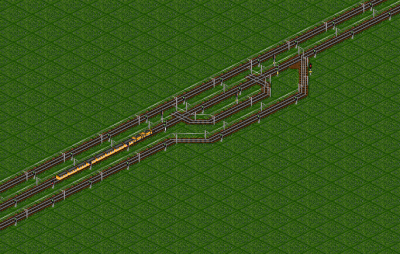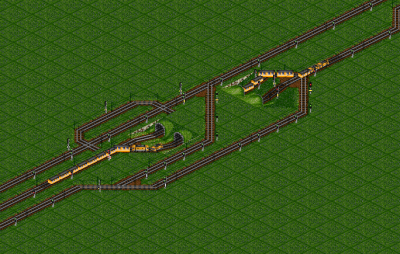Priority
From #openttdcoop wiki
Priorities, or prios, are constructions we use to give an important track priority over another, less important track. Priority can be made in many ways, all which will be covered here.
Contents
Using two-way signals
This is the easiest way to create priority. Use it with care though; when you have multiple two-way combo signals in a row the entire row will be red if one further down the line is, which will cause trains behind the one triggering the prio to stop. This kind of prio should be limited to one combo signal and an exit signal, making it only useful for very short trains or to avoid obstacles in more advanced prios.
Standard prios
This is the preferred way to make prios; it can be made infinitely long without causing any delays. It works as follows: a train on the mainline triggers the first of the combo signals on the parallel prio track, which then triggers all combos in the row, effectively making trains on the sideline wait when a train on the mainline is within 9 tiles of the merging point.
Note that you don't actually have to connect the parallel track to every gap between the signals, as long as the gap between the connections is not longer than the shortest trains on the network you're fine.
Standard prio over a bridge
When you're building compact hubs youll often find this trick to come in handy.
The risk using this construction is that the gap between the connections to the parallel track becomes longer than the train on the mainline, in which case the prio won't trigger. This makes it pretty much un-usable for networks with trainlengths shorter than 4.
PBS prio
PBS introduced some interesting ways to make prios. This prio does exactly the same as the pre-signalled one:
PBS prio over bridge
The most interesting prio PBS introduces is the prio over a bridge. Using this technique you don't need a parallel track to have priority over a bridge, also you don't have to worry about the long gap between the connections anymore.
Limited space and same side prio
Space limitation is something what is faced in every game. Here is the basic example how to build prio at the same side of joining track. Consider situation you cannot built prio on the other side as usual (because of another track there). Priority is instead shortened at the end and built at the same side as joining track. In order to relay information from shortened prio to the joining track entry signal we use one two-ways combo pre-signal, which behaves as regular signal (therefore not disrupting the flow) plus it relays information from the priority to the entry signal on joining track.
Limited space and prio over used tunnel
What if we want to join sideline into two tracks mainline and we don't have much space in neither direction. Not only we need priority on the same side as the inner (closer) track, but we also have tunnels coping with traffic plus undermining the other joining track right before we join the inner one. Using only pre-signals would require extra tunnel or bridge to relay the information, but we do not have space for it. Therefore we use one-way PBS at the tunnel split to avoid using multiple signals and add short dummy track tile with exit pre-signal on the line with second used tunnel. At the end of said tunnel we use two-ways combo pre-signal instead of regular signal. That will work both as regular signal coping with traffic plus it will relay the prio information to the entry pre-signal on the joining track. Naturally such design would work with bridges as well.
There is a drawback however to this design. It is the inability to shorten the priority, because it is always at least slightly longer then the tunnel.
